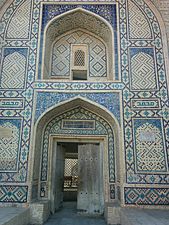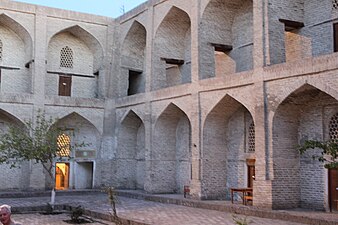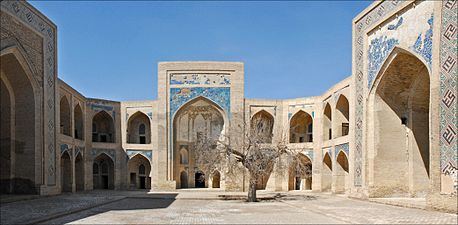Qo'sh Madrasa (Buxoro)
The Qo'sh Madrasa is a double madrasa in the Uzbek city of Buxoro .
location
The Qo'sh Madrasa ( location ) is located in the historic center of Buxoro about 400 meters southwest of the Ark Citadel . It consists of two individual madrasas, the Modari-Khan-Madrasa ( location ) in the east and the Abdullah-Khan-Madrasa ( location ) in the west, which face each other according to the Kosh principle . To the west of the double madrasa is the Samanid Recreational Park with the Samanid Mausoleum , the Chashmai Ayyub Mausoleum and a pond. The Baland Mosque is located about 350 meters south of the Qo'sh Madrasa .
history
Unlike, for example, the Ulug'bek Madrasa and the Abdulaziz Khan Madrasa , which also face each other in accordance with the Kosch principle, but were built more than 200 years apart, the Modari Khan Madrasa and the Abdullah Khan Madrasa are Madrasa was built in quick succession under Khan Abdullah II . They therefore form a uniform building complex and, due to their arrangement in accordance with the Kosch principle, are generally treated in the literature as a Qo'sh Madrasa rather than separately from one another as individual buildings.
The older of the two madrasas is the Modari Khan Madrasa, it was built between 1566 and 1567. The Abdullah Khan Madrasa followed in 1590.
arrangement
The main facades of the Modari Khan Madrasa and the Abdullah Khan Madrasa are almost identical to each other in terms of their architectural form and are of the same size. Both have a pishtak with Iwan in their middle , on each side of which there are three axes of two-story pointed arch arcades with entrances to the individual living cells of the students, and a three-quarter-round corner tower at each corner, which ends with the roof edge. The two facades with all of their individual elements are arranged strictly mirror-symmetrically to one another in accordance with the Kosch principle. In this respect, with the space between them, they form a prime example of a Kosh madrasa .
However, the Kosch principle is interrupted by the fact that the two madrasas do not have the same main axis, but the axis of the Modari Khan madrasa is arranged at an angle to the axis of symmetry connecting the two facades.
Modari Khan Madrasa
The Modari Khan Madrasa is named after the mother of Khan Abdullah II (Modari Khan = mother of the Khan). In order to adapt the facade to the course of the street at the time of construction, it was placed at an angle to the main axis of the madrasa so that it has a trapezoidal floor plan. As a result, the vestibule and the classrooms , for example, are not aligned as is usually the case, but offset from one another. However, the inner courtyard is again symmetrically designed as a rectangle measuring 25 × 27 meters. It is enclosed by two-storey pointed arch arcades with entrances to the students' living quarters and follows the two-iwan scheme: on the entrance side in the west and the opposite east side of the madrasa, two pishtaks with iwans face each other.
Abdullah Khan Madrasa
The Abdullah Khan Madrasa is named after Khan Abdullah II himself. It is 75 meters long and 40 meters wide. Extensions that protrude from the north and west sides of the madrasa are unusual. The decor of the entrance ivan has a 5-way symmetry of rotation, as is known from the use of the Girih tiles . The patterns, however, are not made of tiles that are attached to one another, but instead are made of appropriately arranged colored glazed bricks.
Behind the entrance there is a high classroom on the south side and a mosque on the north side, both of which are vaulted by a dome . The axis of the mosque is laid out in a north-south direction and is thus arranged at an angle to the main axis of the madrasa.
The inner courtyard is enclosed by two-storey pointed arch arcades with entrances to the students' living quarters and follows the four-iwan scheme : two pishtaks with iwans face each other in pairs in the middle of the four wings of the madrasa.
literature
- Klaus Pander: Medrese Madar-e Khan / Medrese Abdullah Khan . In: Central Asia . 5th updated edition. DuMont Reiseverlag , 2004, ISBN 3-7701-3680-2 , chapter Bukhara, the noble , p. 167 ff . (DuMont art travel guide).
- Bradley Mayhew, Greg Bloom, John Noble, Dean Starnes: Other sights . In: Central Asia . 5th edition. Lonely Planet , 2010, ISBN 978-1-74179-148-8 , chapter Bukhara , p. 263 .
Web links
- Kosh-Madrasah, Bukhara at Advantour (English)











